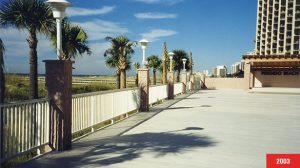How Do Fiberglass Products Endure Hurricanes?
Fiberglass products are increasingly engineered to meet the highest standards of testing specifications, including the Federal Emergency Management Agency’s (FEMA) 320 testing. This specification provides near-absolute protection in the event of extreme winds characteristic of tornadoes and hurricanes. In this context, FEMA defines ‘near-absolute protection’ as:
“Based on our current knowledge of tornadoes and hurricanes, the occupants of a safe room built according to the guidance in this publication will have a high probability of being protected from injury or death.”
 Coastal regions in the tropics have always had to contend with extreme weather events, from regular meteorological depressions to extreme tropical cyclones. These occur with the greatest frequency between June 1st and November 30th; a period that has been dubbed the Atlantic hurricane season. Early in 2019, the National Oceanic Atmospheric Administration (NOAA) predicted an average storm season in the Atlantic basin, which meant coastal regions in the south-eastern United States could expect as many as fifteen individual storms with sustained wind speeds exceeding 39 miles per hour (mph). At least two of these were expected to be major hurricanes.
Coastal regions in the tropics have always had to contend with extreme weather events, from regular meteorological depressions to extreme tropical cyclones. These occur with the greatest frequency between June 1st and November 30th; a period that has been dubbed the Atlantic hurricane season. Early in 2019, the National Oceanic Atmospheric Administration (NOAA) predicted an average storm season in the Atlantic basin, which meant coastal regions in the south-eastern United States could expect as many as fifteen individual storms with sustained wind speeds exceeding 39 miles per hour (mph). At least two of these were expected to be major hurricanes.
Fiberglass Products & Tropical Storms
Tropical storms with sustained surface winds approaching 39 miles per hour (mph) are generally defined as depressions, which are often dismissed as the least damaging climatological phenomenon of the season. Yet their impact can still be costly and potentially life-threatening. The winds associated with tropical storms can cause damage to homes and infrastructures, particularly where materials are inefficiently reinforced.

We explored the importance of wind load resistance in depth in a previous post: The Benefits of Fiberglass Products for Utility Applications.
Fiberglass Products & Hurricanes
When a tropical storm reaches wind speeds exceeding 74 mph it is officially designated a hurricane. The Saffir-Simpson Hurricane Wind Scale rates storms from 1 – 5, with category 3 and above being considered major events due to their higher potential for loss of life and catastrophic damage. A category 3 hurricane with wind speeds of 110 – 129 mph can completely remove the roofs from homes due to extreme uplift wind loads. The devastation from a category 5 hurricane, meanwhile, can be total.
The Department of Homeland Security recommends taking shelter in a FEMA-rated storm shelter to seek protection in the event of a major hurricane event. FEMA 320 testing measures the capabilities of products, such as storm panels, in response to ground speeds of up to 250mph. These tests are conducted using simulated impacts to observe and characterize the behavior of materials in response to flying debris. Fiberglass products rated to FEMA 320 standards vastly exceed the likes of plywood in terms of impact resistance without cracking; a result of proprietary mixtures of ballistic grade roving and functional resins. This enables the fiberglass product to absorb significant impact forces without delaminating.
Read a full comparison of our HS Storm fiberglass products to ¾” plywood sheets in our previous post Comparing Fiberglass Storm Panels to Plywood.
Storm-Resistant Fiberglass Products from Strongwell
Strongwell specializes in pultrusion of fiberglass products for demanding downstream applications, including storm-proofing for commercial and domestic properties in hurricane afflicted regions. If you would like any more information about our HS Storm fiberglass products, simply contact a member of the team today.
[Sources: FEMA, NOAA]